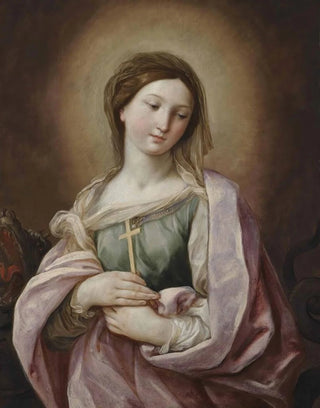Art print | Saint Marguerite d'Antioche - Guido Reni


View from behind

Frame (optional)
The canvas "Saint Marguerite of Antioch" by Guido Reni, created in the early 17th century, is part of the great Italian baroque tradition. This artwork, imbued with spirituality and visual power, highlights the iconic figure of Saint Marguerite, a Christian martyr, whose legend is rich in symbols of faith and resistance. Through this painting, Reni manages to capture not only the physical beauty of his protagonist but also the intensity of her devotion, offering an aesthetic experience that transcends the mere religious context. The light, colors, and expressions are skillfully orchestrated to invite the viewer to a deep and emotional contemplation.
Style and uniqueness of the work
Guido Reni's style is distinguished by its elegance and delicacy, characteristic of classical baroque. In "Saint Marguerite of Antioch," Reni uses a palette of soft colors, dominated by warm and luminous tones, which give the artwork an atmosphere that is both serene and dynamic. The composition is carefully balanced, with a staging that directs the gaze toward the central figure of the saint. The flowing drapes of her dress, combined with subtle lighting, create a movement effect that seems to animate the canvas. The depiction of the saint, with her expression both gentle and resolute, demonstrates the artist's mastery in rendering human emotions. Every detail, from the face to the accessories, is treated with meticulous precision, revealing a deep understanding of anatomy and psychology of the characters.
The artist and his influence
Guido Reni, an emblematic figure of the baroque, knew how to mark his era with his innovative approach to religious painting. Trained in the shadow of the great masters, he developed a style that combines classicism and emotion, influencing many artists of his time and future generations. His work, often imbued with mysticism, resonates with a modernity that continues to inspire contemporary creators. Reni managed to capture the essence of his subjects, giving them an almost divine dimension, while remaining accessible to the viewer.

Matte finish

View from behind

Frame (optional)
The canvas "Saint Marguerite of Antioch" by Guido Reni, created in the early 17th century, is part of the great Italian baroque tradition. This artwork, imbued with spirituality and visual power, highlights the iconic figure of Saint Marguerite, a Christian martyr, whose legend is rich in symbols of faith and resistance. Through this painting, Reni manages to capture not only the physical beauty of his protagonist but also the intensity of her devotion, offering an aesthetic experience that transcends the mere religious context. The light, colors, and expressions are skillfully orchestrated to invite the viewer to a deep and emotional contemplation.
Style and uniqueness of the work
Guido Reni's style is distinguished by its elegance and delicacy, characteristic of classical baroque. In "Saint Marguerite of Antioch," Reni uses a palette of soft colors, dominated by warm and luminous tones, which give the artwork an atmosphere that is both serene and dynamic. The composition is carefully balanced, with a staging that directs the gaze toward the central figure of the saint. The flowing drapes of her dress, combined with subtle lighting, create a movement effect that seems to animate the canvas. The depiction of the saint, with her expression both gentle and resolute, demonstrates the artist's mastery in rendering human emotions. Every detail, from the face to the accessories, is treated with meticulous precision, revealing a deep understanding of anatomy and psychology of the characters.
The artist and his influence
Guido Reni, an emblematic figure of the baroque, knew how to mark his era with his innovative approach to religious painting. Trained in the shadow of the great masters, he developed a style that combines classicism and emotion, influencing many artists of his time and future generations. His work, often imbued with mysticism, resonates with a modernity that continues to inspire contemporary creators. Reni managed to capture the essence of his subjects, giving them an almost divine dimension, while remaining accessible to the viewer.






